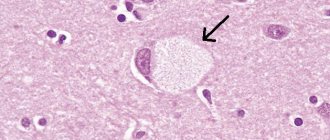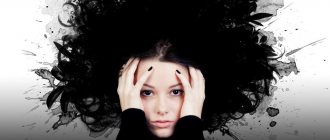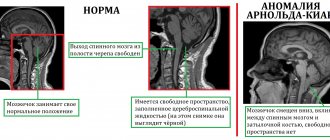Author: Soldatenkov Ilya Vitalievich
, for sindrom.info ©
Oneiroid is a psychopathology characterized by a qualitative clouding of consciousness, which is manifested by plot-related pseudohallucinations, fantastic dreams, daydreams, experiences, delusions, illusions, the appearance of unusual images and fragments, and the patient’s detachment from society. The imagination of patients reaches the level of contemplation. These phenomena in the subconscious are combined with real events and gradually replace them.
The term "oneiroid" translated from ancient Greek means "type of dreams." Oneiric syndrome was first discovered in 1894 by researchers in the field of infectious psychoses. In 1924, the pathology was described in detail by a psychiatrist from England, Mayer-Gross, who observed a patient with schizophrenia. In 1950, the Hungarian psychiatrist L. Meduna identified schizophrenia with oneiric disorder as a separate nosological entity. There have been debates and debates around this disease for a long time, significant disagreements among doctors arose, and there was no uniform terminology. Modern scientists have found that oneiric syndrome is a manifestation of various diseases: psychiatric, infectious, oncological, vascular and others.
Diseases in which oneiroid most often develops:
- Schizophrenia,
- Psychoses,
- Epilepsy,
- Traumatic brain injury,
- Alcohol and drug intoxication.
The syndrome is characterized by a staged course and is accompanied by disturbances in thought processes, speech, emotional and psychomotor state. Persons with oneiroid are characterized by ambivalence of behavior. They experience contradictory and ambivalent experiences. The simultaneous occurrence of two antagonistic feelings in patients is a sign of pathology.
Foxes with oneiroid have impaired or completely absent spatial-temporal orientation. Patients contemplate unknown things that others do not notice. Their perception of the subject changes, their own “I” is transformed by turning into an animal or an inanimate object. Participants in pseudohallucinatory situations include people around them in their fantasies.
Oneiroid is characterized by the alienation of patients from the outside world. An atypical relationship between vivid, sensual fantasies and modern realities arises in their minds. During an attack, the patient's face becomes mask-like, and their gaze becomes absent or frozen. The patients are silent and outwardly indifferent, without contact. In the post-attack period, they easily and in great detail retell their experiences and visions.
The advanced form of oneiric syndrome occurs mainly in adolescents in combination with catatonic stupor. In schoolchildren and preschool children, individual signs of pathology appear, which over time combine and form a full-fledged picture of oneiroid. In elderly people, pathology develops extremely rarely. Based on the expressed clinical picture and anamnestic data, a diagnosis is established. All patients are given pharmacological treatment taking into account the true cause of the syndrome.
Classification
There are different types of oneiroid:
- patients are completely immersed in their imagination, separating from the outside world, becoming indifferent, detached, non-contact.
Dreamlike- Fantastic-illusory - an interweaving of fantasies, dreams and illusions with events occurring in real life.
- Dream-oriented - complete immersion of patients in their dreams with the perception of objects and phenomena that do not really exist, located in subjective mental space and not having the nature of objective reality.
- Scenic-hallucinatory - the predominance of auditory, visual, tactile and other pseudohallucinations in the clinical picture.
- Alcoholic – characterized by peculiar symptoms, progresses from delirium and occurs after withdrawal of alcohol or taking a low-quality surrogate.
- Post-stroke is a complication of acute brain failure.
- Expansive - admiration of one’s personality, being in the world of fairy-tale dreams and colorful fantasies with romantic plots, friendliness, absence of danger, joy, pleasure.
- Depressive - low mood, suppression of intellectual activity, motor and volitional inhibition, suppression of instincts, difficulties in concentrating, focusing on painful experiences, low self-esteem, nightmares, constant expectation of danger, predominance of negative emotions - anxiety, fear, despondency, apathy, tearfulness .
- Manic – activation of the patient, optimistic mood, joy of life, elevated mood, mental arousal, acceleration of thinking and speech, motor excitement.
How does oneiroid manifest?
Patients experience complex scene-like hallucinations.
The picture of a full-blown oneiroid syndrome consists of disturbances in orientation and level of self-awareness, the presence of abundant complex illusory-hallucinatory disturbances of perception, most often of fantastic content. Characterized by deep immersion in experiences with a decrease in the degree of contact with the outside world, which often makes it possible to diagnose a concomitant catatonic syndrome.
The psychopathological basis of the full-blown oneiric state is pseudohallucinations of a visual, auditory and tactile nature. A person “sees” bright scene-like plot images unfolding before his inner gaze and participates in these events, feeling himself in a different world and even in a different capacity. Total pseudohallucinosis deeply disorients the patient; he is unable to realize the painfulness of his experiences and does not pay attention to the events that are actually occurring.
Pseudohallucinations capture the patient’s internal subjective mental space and unfold, as it were, inside his consciousness. They are the basis for the development of systematized fantastic sensory delirium. A person experiencing oneiroid may consider himself to be someone else (a mythical character, a hero of a novel, an alien being, the embodiment of divine powers, etc.), and this belief persists for some time after leaving the oneiroid state.
The experiences and sensations experienced are integral, coherent, colorful and affectively rich. They intricately intertwine objects and events of the surrounding world, people, illusions and hallucinations, all of which add up to a vivid dream-like or dream-like disorder of consciousness. There are also everyday contents of hallucinatory-delusional experiences, and they most often have a negative emotional connotation and are even threatening in nature.
Characterized by a pronounced dissociation between the vivid, often polar emotions he experiences and the existing external manifestations. A person in oneiroid is immersed in his experiences. He looks inhibited and even numb, most often lies with his eyes open, sometimes makes individual movements of his limbs in accordance with the content of his dreams
Exposure to strong external stimuli in some cases can attract the patient's attention for a short time. At the same time, he can answer some questions and briefly report the essence of his experiences, but he looks confused and disoriented
When examining a person in oneiroid, the doctor notes a substuporous or stuporous state; manifestations of catatonic syndrome are possible.
Oneiroid is characterized by a violation of orientation in time, space and partly in one’s own personality. During the period of an altered state of consciousness, a person seems to live through quite long episodes, during which he “manages” to visit other planets, take part in battles and sea battles, visit heaven (or hell), and experience the end of the world. After leaving the oneiroid, the memory of these experiences is retained; at first the patient is uncritical and convinced of the truth of these visions. But the events that actually take place during this period are not remembered. As the general condition improves, the emotional intensity of memories decreases, and partial anterograde amnesia develops.
Etiology
Oneiric syndrome is a nonspecific polyetiological pathology, which is a manifestation of various disorders: psychiatric diseases, severe intoxications, effects of anesthesia, viral and bacterial infections, neurological pathology, somatic non-infectious diseases, autoimmune diseases, endocrinopathies. In addition to psychogenic provocation, heredity plays a great role in the development of the disease.
- Mental illnesses – paroxysmal schizophrenia and manic-depressive psychosis.
- Exogenous intoxication caused by exposure to chemical, medicinal, narcotic and other toxic substances.
- Organic brain damage.
- Use of anesthesia during operations.
- Viral infections - cytomegalovirus, influenza and parainfluenza virus, herpes virus.
- Bacterial infection occurs in the form of sepsis, meningitis, meningoencephalitis.
- Neurological pathology - epilepsy, panic disorders against the background of acute encephalopathy, dyscirculatory disorders.
- Cardiovascular dysfunctions - stroke, myocardial infarction, heart failure, vascular dementia.
- Autoimmune disorders - rheumatism, vasculitis, SLE.
- Metabolic disorders - hypovitaminosis, pellagra.
- Endocrinopathies.
- Neoplasia leading to cachexia, chronic asthenia.
- Injuries accompanied by painful shock and blood loss.
If the cause of the pathology is exogenous intoxication - the use of psychotropic drugs, drugs, medications, the syndrome quickly progresses and has vivid symptoms. The wave-like course of oneiroid is characteristic of discirculatory phenomena and organic diseases of the brain.
When can oneiroid develop?
Oneiroid can develop due to the use of alcohol or psychoactive substances.
Oneiroid is not a disease-specific syndrome. It can be of exogenous and endogenous nature. The disease is said to be endogenous in the absence of signs of intoxication and any clinically significant disturbances in the functioning of internal organs. This is possible in a number of mental illnesses: schizophrenia (especially in its oneiric-catatonic form) and bipolar affective disorder, if it occurs with psychotic disorders.
The causes of the exogenous form of oneiroid syndrome can be:
- acute intoxication with psychoactive substances or other compounds that are used for narcotic purposes (glue, gasoline, acetone);
- the effect of certain drugs used for general anesthesia (anesthesia);
- alcohol and metal intoxication;
- various infectious diseases of a bacterial or viral nature, occurring with severe intoxication and hyperthermia;
- encephalitis, meningoencephalitis of various etiologies;
- epilepsy with the development of epileptic psychoses or mental equivalents of convulsive seizures;
- non-infectious diseases of internal organs with pronounced changes in metabolism or severe vascular disorders (myocardial infarction with acute heart failure, damage to the kidneys and liver with the development of insufficiency of their function, other diseases);
- systemic lupus erythematosus;
- severe pellagra;
- endocrine pathology (diabetes mellitus, Itsenko-Cushing's disease, adrenogenital syndrome, thyrotoxicosis, Addison's disease);
- a malignant tumor of any localization, if it leads to cancer cachexia and intoxication.
Oneiroid is often a manifestation of somatogenic psychoses. This is due to the development of acute encephalopathy of vascular or intoxication origin in many severe somatic diseases. In the case of infection, the cause of qualitative disturbances of consciousness may be direct diffuse damage to neurons, the development of toxic swelling of nervous tissue, or impaired microcirculation in the brain.
Symptoms
Oneiric stupefaction develops in five stages, each of which has specific clinical symptoms. The stages have very blurry outlines and smoothly flow into each other.
- Initial stage: unstable mood - increased or decreased, sleep disturbances - insomnia or colorful dreams, neurovegetative signs - cardialgia, impotence, cephalgia, loss of appetite, hyperhidrosis, facial flushing. Patients suffer from fear of insanity.
- The stage of the appearance of delusional ideas - delusions of death, incurable illness or persecution are often combined with hallucinosis, illusory ideas, increased tension, paranoia, disorder of thinking processes, expressed in incorrect perception of the surrounding world.
- The stage of emotionally charged delirium of staging, during which patients develop derealization and depersonalization, illusions and mental automatisms appear. The surrounding objects change externally, and faces also internally. Living people are replaced by doubles, faces and characters are transformed. Patients consider themselves heroes of myths and works of art, aliens and strangers.
- Paraphrenia with fantastic or megalomanic delusions is a stage of pathology in which patients become the center of the Universe. They communicate with angels and demons, are in the midst of the struggle between good and evil, and consider themselves significant and great. In their subconscious, terrible hallucinations arise about disasters, mass deaths, and the end of the world. Often a person does not realize where he is, gets lost in time and space, and becomes dangerous to others.
- The stage of expanded oneiroid - the world of dreams and fantasies exceeds real life. Patients participate in their own pseudo-hallucinations, they are immersed in fairy-tale scenes and implausible plots. They actively fight the otherworldly world of spirits and become participants in global disasters. The patient subconsciously goes through all stages of the development of pathology: from the spectator and the main character to the victim of the unfolding events. This is the climax of the attack. Clinical signs of this stage are disorientation, confusion, and illusory-hallucinatory fantasies. Patients become self-absorbed and stop contacting others. With total pseudohallucinosis, painful experiences overtake a person who no longer perceives real events. During an attack, patients become numb, do not make contact, their gaze is fixed at one point.
- The reverse development of pathology, in which patients clearly remember and colorfully describe their painful experiences.
Main clinical manifestations of the syndrome
Emotional stress is the first manifestation of the syndrome. The lability of emotions, their changes in a negative or positive direction lead to sleep disorders, manifested by insomnia or vivid dreams. Constant fear drives patients crazy. Signs of manic oneiroid are that patients are hyperactive, they admire and are touched, they perceive current events favorably and joyfully. Depressive oneiroid is manifested by apathy, anxiety, irritation, and asthenia. Patients often experience changeable feelings: from lethargy, lack of initiative, frustration to excessive ambition and soulfulness.
Disorders of mental and speech functions are manifested by delirium, dual orientation, and disturbed sequence of thoughts. A delusional mood is manifested by unsystematized delusions of persecution, death, and hypochondria. The delusion of staging is accompanied by verbal illusory-hallucinatory phenomena, transformation of images and objects, a feeling of alienation, unnaturalness, “made-up” of one’s own movements, acceleration or deceleration of speech. The paraphrenic stage is a fantastic retrospective and Manichaean delirium with preservation of self-awareness. Patients tell how they saw a staircase in a large hall, along which angels descended and demons ascended. They first become witnesses to a grandiose battle, and as the pathology develops, they become participants in the events. The self-awareness of patients is gradually impaired. They are completely immersed in pseudo-hallucinations. Verbal contact with patients is impossible because they speak slowly and slurred.
A disorder of the volitional sphere is a sign of a developed pathology. Patients rarely experience psychomotor agitation. Usually they experience numbness and detachment, their facial expressions are monotonous and “frozen.” Phenomena of catatonia are possible - stupor or hyperactivity, absent-mindedness and inability to concentrate on a specific object, amnestic symptoms - remembering and accurately reproducing painful experiences with loss of memory for real events.
Hallucinations - patients travel between planets, communicate with Martians, go to the Moon and perform a certain mission there; on the streets of the city they organize uprisings, lead naval battles, fight with pirates, experience the end of the world, become sites of destructive actions - cities perish under their leadership, millions of people die, volcanoes erupt, earthquakes occur, planets collide. Fantasies become more and more colorful and fabulous. The patient answers questions evasively, speaks in short phrases, often incomprehensible to the interlocutor, he is confused and indistinctly addresses himself mostly to himself. At the same time, facial expressions are not thematic or are completely absent. Gradually he goes into the world of dreams and falls into his dreamlike state, not noticing the real dangers. After emerging from oneiroid, patients remain convinced of the truth of their visions for a long time.
Oneiroid is divided into two types
Oneiric state, accompanied by modification and reincarnation of one’s own self (dream-like oneiroid). And the oneiric state, in which a bizarre mixture of fragments of the real world and vivid fantastic ideas actively emerging in the consciousness occurs (fantastic-illusory oneiroid).
With dream-like oneiroid, patients feel like participants in fantastic, sometimes dramatic events playing out in their imagination. With fantastic-illusory oneiroid, fantastic and dramatic events are played out not in the patient’s imagination, but in the environment around him. In their fantastic oneiric experiences, patients act as historical figures, generals, emperors, and cultural figures.
The content of events in oneiric syndrome can also be different; most often it is ordinary, most often fantastic. People with oneiroid stay on other continents, planets, in space, in non-existent worlds, in other times. In oneiroid, patients participate in battles, in nuclear war, and witness the death of the universe. In some cases, oneiroid hallucinosis may be observed as a harbinger of developing oneiroid.
With oneiroid, catatonic syndrome or so-called oneiric catatonia is quite often observed.
Oneiric catatonia manifests itself in stereotypical movements, rocking, direct disobedience to doctors' requests, and execution of opposite commands.
Most often, oneiroid is a sign of an acute attack of schizophrenia. The attack usually begins quickly, combined with delusional ideas about flights, travel, wars, and world catastrophes.
Oneiric syndrome can also be caused by exogenous factors, such as the use of various psychoactive substances: hallucinogens, cannabinoids, ketamine, etc. or hormonal drugs such as corticosteroids.
Home-based drug treatment will help you get rid of this disease if it is caused by taking narcotic substances. With rapid diagnosis and immediate treatment, the prognosis for oneiric syndrome is favorable. Treatment for oneiric syndrome is always carried out in a hospital setting.
Diagnostic measures
Diagnosis of the oneiric state is quite complex. Sometimes patients do not have any complaints, except for an increase in internal tension, inhibited reaction, insomnia, and depression. These manifestations are nonspecific. They do not allow one to suspect this disorder. Psychiatrists talk with the patient and his relatives, collect a life history, and observe manners and behavior. All this data is extremely important for making a diagnosis. In addition, a comprehensive analysis of somatic and neurological status is required. The results of laboratory and instrumental diagnostics are often decisive.
- Patients need to donate blood for general clinical and biochemical tests, cerebrospinal fluid for cytological, histological and microbiological studies.
- Instrumental diagnostic methods - tomographic and x-ray examinations of the skull.
- The psychological state of the patient is determined using special tests and scales.
Symptoms and signs of oneiroid
Oneiric clouding of consciousness in its symptoms is similar to all types of clouding of consciousness, but has some differences
It is important to take into account the emotional component of this pathology, since the effect is very pronounced. With manic, the person is completely captured by his experiences, active, energetic, and with depression, he is drooping and sad, but still in his experiences
Their speech is quite slow, slurred and does not correspond to situational aspects. Thinking is fragmented, orientation is ambiguous, consistency is disrupted. Amnesia is incomplete and manifests itself in the form of memory impairment with pronounced memories of pathological experiences, but forgetfulness of real events. The effector-volitional sphere is also affected, instincts are reduced, emotions are inexpressive, the person is confused and drowsy.
Emotional disturbances are the first to form; the person is lethargic, lacking initiative, as if upset by something. But such a mood, like any other, is unstable and changes abruptly for no reason to another. Often such people are afraid to sleep, because their dreams are frightening, terrifying, and they try to avoid such terrible moments as much as possible. Insomnia is a common companion to disorders of consciousness. It is impossible to hide the signs of affect that have arisen; the person is moved or is in complete, as it seems to him, hopelessness.
When talking with a person, behavioral shifts will immediately be noticeable, which will manifest themselves in delusional ideas. Perceptual disturbances are also not uncommon in these conditions, and there may be illusions and scene-like hallucinations.
The dream-like oneiroid especially manifests itself in the presence of hypnagogic hallucinations, in which a person, closing his eyes, sees certain scenes and people. There will be no point in communicating with such patients; they speak in pieces, in broken words, and it is impossible to trace the thread of the conversation. The speech itself is slurred, changing, sometimes speeding up, sometimes slowing down. Self-orientation is partially preserved, but still it is impossible to maintain contact with a person, he is confused, speaks more to himself than to someone, and even indistinctly. In time, as well as in the place around them, they are absolutely not oriented; time drags on or runs by for them. At the same time, a person is confident in the artificiality of his actions; there are mental automatisms.
The universe of such a person changes radically, while the person performs the usual actions, but his consciousness lives an absolutely unique life of its own. At the same time, he does everyday things, at the same time fights evil, destroys the devil or cosmic evil.
Their facial expressions are not thematic; their faces may even be mimicic. Over time, this duality worsens, until a complete withdrawal into the world of dreams. The movements become similar to each other, he already falls into his dreamlike state so much that he is able to fail to notice real dangers.
It is also important to distinguish the underlying cause of the disease, since the symptoms are different. For infectious causes, there is intoxication and complaints from the head
In case of poisoning, there are additional complaints such as diarrhea and vomiting. When using drugs, it is important to seek an appropriate history.
Healing procedures
Patients with oneiric syndrome are treated in a psychiatric clinic under the supervision of medical personnel. The treatment regimen is drawn up by a psychiatrist taking into account the cause of the pathology.
General therapeutic measures include:
- Detoxification – intravenous administration of saline solutions, glucose, “Reopoliglucin”, oral administration of “Rehydron”, “Atoxil”, “Enterol”,
- Diuretics - Mannitol, Lasix,
- Neuroleptics - “Azaleptin”, “Haloperidol”, “Aminosin”, “Tizercin”,
- Antidepressants - Prozac, Coaxil, Amitriptyline,
- Sedatives – “Afobazol”, “Persen”, “Novopassit”,
- Nootropic drugs – “Pantogam”, “Semax”, “Piracetam”,
- Cytoprotectors – “Actovegin”, “Riboxin”, “Trimetazidine”,
- Antioxidants – “Mexidol”, “Glutamic acid”, “Glycine”,
- Vascular drugs – “Trental”, “Vinpocetine”, “Cinnarizine”,
- Neuroprotectors - Phezam, Thiocetam,
- Tranquilizers – “Sibazon”, “Relanium”,
- Antispasmodics – “Papaverine”, “Drotaverine”, “Spazmalgon”,
- Broad spectrum antibiotics for infectious diseases,
- Electroconvulsive therapy is performed in severe cases.
With severe psychomotor agitation, patients require physical restraint. However, in most cases, calming psychotherapy is sufficient.
The prognosis of oneiroid is determined by the course of the underlying disease. After quality psychiatric treatment, patients may require consultation with specialists.
Oneiroid - what is it?
Oneiroid is a common psychiatric word that comes from Greek and means a dream-like appearance. This concept, slightly modified, was first described at the end of the 19th century by the psychiatrist Regis during intoxication. And for the first time, oneiroid was called so, as they say until now, at the beginning of the 20th century, and this was done by the outstanding Clerambault, who had a hand in describing many conditions in the psychiatric industry. This term was further refined for a long time; it took many medical scientists and research to study it well and describe it thoroughly. And this is not surprising; this condition is not very common compared to many others.
Oneiric syndrome is a syndrome of stupefaction, which belongs to the productive syndromes of impaired awareness. In oneiroid, an unauthorized influx of periodically appearing fantastic dream-like delusional hallucinations appears in the form of pictures that are complete in their essence, which alternate in a separate purposeful sequence and create one whole.
Oneiroid is accompanied by partial and sometimes complete alienation from the outside world. There are disturbances of self-awareness, accompanied by various affects, the most common being manic or depressive. There are signs of catatonia with preservation of the composition of experiences in consciousness with amnesia for reality.
Much in psychiatry, as in all medicine, is changing quite radically. This is what happened with the term oneiroid, which was included in the subtype of delirium, so in ICD 10, as well as, sometimes in life, it can be difficult to separate them. But still, these conditions have their own characteristic differences, which are well known to practicing psychiatrists.
In the domestic literature, Snezhnevsky’s classification of oneiroid is used, which has several subclasses. An important criterion is orientation, so there is a classification according to this criterion. The dream-like oneiroid resembles a dream-event, while the person is alienated from his surroundings, but the events of his dreams fascinate him very much. The fantastic-illusory oneiroid demonstrates a different state, manifested in a mixed orientation; both reality and fantasy experiences are present at the same time.
According to the reasons, oneiroids, like many other psychiatric problems, can be many, but several very significant and very different ones are worth highlighting, namely:
• Alcoholic oneiroid is a separate, unique type of oneiroid that progresses from delirium for the same reason. It differs from the usual oneiroid because alcoholics have a completely different perception.
• Oneiroid after a stroke is of an organic nature; often after such severe conditions this complication is possible. Often, when you come into contact with this in a neurological hospital, this condition inspires fear.
• Since oneiroid is very characterized by the emergence of affect, in the form of a special behavioral mood, this classification is also very relevant. Behavior during different affects is very different, which affects the course of the process and the treatment used.
• An expansive oneiroid manifests itself by universal admiration of the individual, complete enthusiasm and stay in his fantasy world.
• Depressive oneiroid completely fetters a person, plunging him into a depressive state for a long time.
• Manic oneiroid, as opposed to depressive one, activates such a person. This is a rather rare type of affect, since in oneiroid a person is still more often immobilized and captured by his fantasies.
Diagnostics
Differential diagnosis
It is first of all necessary to differentiate oneiric syndrome from a concept very close to it - oneirism. It manifests itself in the fact that the patient’s vivid dreams upon awakening cannot be distinguished from reality, but it seems to him that they were in reality. The critical attitude, however, quickly returns. With severe oneiric syndrome, it is enough to simply close your eyes to see dream experiences. At the same time, criticism disappears and motor excitement appears. The content of the experiences is everyday or professional. Delirium is possible, but there are no true hallucinations. Oneirism occurs more often with burn disease, sepsis, and inflammatory diseases.
Story
The concept of “oneiric delirium” (see onirism) was first used by E. Regis in 1894 when describing psychoses due to infections and intoxications. The term “oneiric delirium” was proposed by the French psychiatrist G. G. de Clérambault in 1909. In 1924, oneiroid as a syndrome was first described by V. Mayer-Gross in the book “Description of Confusion. A form of oneiric experience" (German: "Selbstschilderungen der Verwirrtheit. Die oneroide Erlebnisform"). In 1961, the Bulgarian psychiatrist S. T. Stoyanov studied the dynamics of the process. Oneiroid was described mainly in psychoses, now classified as recurrent schizophrenia. With it, it appears in the most complete form, and its development goes through a number of successive stages.








